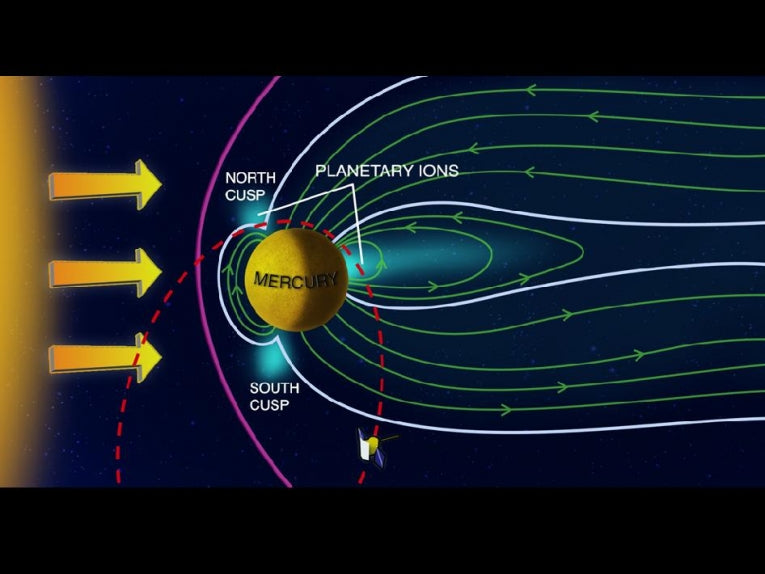Image Credit: © Science/AAAS; Mercury's planetary magnetic field largely shields the surface from the supersonic solar wind emanating continuously from the Sun. MESSENGER has been in a near-polar, highly eccentric orbit (dashed red line) since 18 March 2011. Maxima in heavy ion fluxes observed from orbit are indicated in light blue
The solar system's smallest and hottest planet, Mercury, is not quite the scorched rock we once imagined. New information coming back to Earth from NASA's MESSENGER spacecraft paints a picture of widespread flood volcanism similar to Earth, the clearest views to date of Mercury's surface, including the discovery of unusual glowing craters (dubbed "hollows") of indeterminate origin, initial measurements of its elemental composition, and new details about charged particles near the planet.
Launched some six years ago, MESSENGER, or the MErcury Surface, Space ENvironment, GEochemistry, and Ranging spacecraft, is the first in history to orbit the fiery, innermost planet. "MESSENGER's instruments are capturing data that can be obtained only from orbit," said principal investigator Sean Solomon, of the Carnegie Institution of Washington. "Mercury has many more surprises in store for us as our mission progresses."

Image Credit: © Science/AAAS; A Large Crater with a Floor Partially Covered by Large Numbers of Coalesced Hollows
Much of the information flooding in is forcing scientists to rethink their preconceptions about the origins, and nature, of the tiny planet. Its magnetic field is unlike that of other planet, including Earth, Jupiter, Saturn, Uranus, and Neptune. The planet's composition also appears to be different than expected, essentially ruling out "extreme high-temperature events" early in Mercury's history. In short, scientists expected to find a lifeless orb similar to our moon.
"The old conventional wisdom was that 'Mercury is just like the Moon.' But from its vantage point in orbit, MESSENGER is showing us that Mercury is radically different from the Moon in just about every way we can measure," said David T. Blewett, a planetary scientist at the Johns Hopkins University Applied Physics Laboratory (APL) and lead author of one of several reports published in the journal Science.

Image Credit: © NASA/Johns Hopkins University Applied Physics Laboratory/Carnegie Institution of Washington; Schematic Illustration of the Operation of MESSENGER's Gamma-Ray Spectrometer (GRS)
Analysis of Mercury's magnetic field reveals that it is too weak to withstand the onslaught of energetic particles radiating from the sun. On our own planet the magnetosphere serves as a crucial shield against the damaging effects of solar wind. "Our results tell us that Mercury's weak magnetosphere provides very little protection of the planet from the solar wind," said University of Michigan's Thomas Zurbuchen, author of one of the Science reports. "Extreme space weather must be a continuing activity at the surface of the planet closest to the Sun."
Another surprising find is evidence that volcanic flows cover up to six percent of the planet's surface. "If you imagine standing at the base of the Washington Monument, the top of the lavas would be something like 12 Washington Monuments above you," said James Head of Brown University, the lead author of one of the papers.










